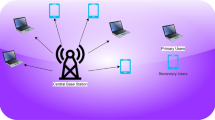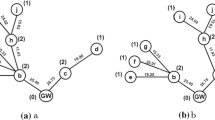Abstract
Compared with conventional direct transmissions, the cooperative transmissions are not always beneficial and redistribute the interference over the network coverage area due to relay transmissions. In this paper, we propose an opportunistic cooperation strategy for a wireless ad hoc network with randomly positioned single-hop source-destination pairs and relays, where each source-destination pair activates the cooperative transmission only when the number of potential relays is not smaller than a cooperation threshold. Such a threshold determines the proportion of concurrent cooperative transmissions and it can be adjusted to enhance the overall network performance. The correlation of nodes’ locations induces the correlation of interference power. Based on stochastic geometry, we derive the correlation coefficient of interference power at a destination during the transmission periods of the sources and relays. The outage probability of opportunistic cooperation is derived for selection combining, while taking into account the interference correlation, relay selection strategy, and spatial distributions of sources and relays. Extensive simulations are conducted to validate the performance analysis. The analytical results evaluate the effectiveness of opportunistic cooperation and provide useful insights on protocol design and parameter setting for large-scale networks.







Similar content being viewed by others
Notes
Adding a node does not affect the statistics of the PPP. According to the Slivnyak’s theorem [29], the average performance of the typical source-destination pair represents that of any source-destination pair in the network.
It is desirable to select the best relay within a constrained region due to the following reasons: 1) the relays geographically far away from the source and/or destination are not beneficial [17]; 2) the protocol overhead and implementation complexity of a relay selection scheme increase with the number of relays that contending to be the best relay [30, 31]; and 3) the efficiency of spatial frequency reuse reduces with a larger relay selection region [19].
The singularity has a negligible effect on determining whether or not a packet is successfully received [8]. For instance, if an interferer locates very close to a receiver, the singular path loss model would result in a very small SIR and hence an unsuccessful packet reception at the receiver. On the other hand, the receiver would also very likely fail to decode the packet even if the singularity is removed (i.e., non-singular path loss model).
In terms of the average number of source-destination pairs per square kilometer.
References
Haas Z, Deng J, Liang B, Papadimitratos P, Sajama S (2002) Wireless ad hoc networks. Encyclopedia of Telecommunications
Lei L, Kuang Y, Shen X, Lin C, Zhong Z (2014) Resource control in network assisted device-to-device communications - solutions and challenges. IEEE Commun. Mag 52(6):108–117
Nosratinia A, Hunter T, Hedayat A (2004) Cooperative communication in wireless networks. IEEE Commun. Mag 42(10):74–80
Shan H, Zhuang W, Wang Z (2009) Distributed cooperative MAC for multihop wireless networks. IEEE Commun. Mag 47(2):126–133
Zhuang W, Zhou Y (2013) A survey of cooperative MAC protocols for mobile communication networks. J. Internet Technology 14(4):541–559
Zhuang W, Ismail M (2013) Cooperation in wireless communication networks. IEEE Wireless Commun 19(2):10–20
Cai LX, Cai L, Shen X, Mark JW (2010) REX: a Randomized EXclusive Region based Scheduling Scheme for mmWave WPANs with Directional Antenna. IEEE Trans. Wireless Commun 9(1):113–121
Weber S, Andrews J, Jindal N (2007) The effect of fading, channel inversion, and threshold scheduling on ad hoc networks. IEEE Trans. Inf. Theory 53(11):4127–4149
Baccelli F, Miihlethaler P, Blaszczyszyn B (2009) Stochastic analysis of spatial and opportunistic ALOHA. IEEE J. Select. Areas Commun 27(7):1105–1119
Ganti R, Haenggi M (2012) Spatial analysis of opportunistic downlink relaying in a two-hop cellular system. IEEE Trans. Commun 60(5):1443–1450
Wang L, Fodor V (2012) On the gain of primary exclusion region and vertical cooperation in spectrum sharing wireless networks. IEEE Trans. Veh. Technol 61(8):3746–3758
Wang H, Ma S, Ng T-S, Poor H-V (2011) A general analytical approach for opportunistic cooperative systems with spatially random relays. IEEE Trans. Wireless Commun 10(12):4122–4129
Behnad A, Rabiei A, Beaulieu N, Hajizadeh H (2013) Generalized analysis of dual-hop DF opportunistic relaying with randomly distributed relays. IEEE Commun. Lett 17(6):1057–1060
Zhai C, Zhang W, Mao G (2012) Uncoordinated cooperative communications with spatially random relays. IEEE Trans. Wireless Commun 11(9):3126–3135
Stoyan D, Kendall W, Mecke J, Ruschendorf L (1987) Stochastic Geometry and its Applications. Wiley, New York
Haenggi M, Andrews J, Baccelli F, Dousse O, Franceschetti M (2009) Stochastic geometry and random graphs for the analysis and design of wireless networks. IEEE J. Select. Areas Commun 27(7):1029–1046
Cho S, Choi W, Huang K (2011) QoS provisioning relay selection in random relay networks. IEEE Trans. Veh. Technol 60(6):2680–2689
Altieri A, Rey Vega L, Piantanida P, Galarza C (2014) Analysis of a cooperative strategy for a large decentralized wireless network. IEEE/ACM Trans. Networking 22(4):1039–1051
Zhou Y, Zhuang W (2015) Throughput analysis of cooperative communication in wireless ad hoc networks with frequency reuse. IEEE Trans. Wireless Commun 14(1):205–218
Ganti R, Haenggi M (2009) Spatial and temporal correlation of the interference in ALOHA ad hoc networks. IEEE Commun. Lett 13(9):631–633
Haenggi M (2012) Diversity loss due to interference correlation. IEEE Commun. Lett 16(10):1600–1603
Tanbourgi R, Dhillon H, Andrews J, Jondral F (2014) Effect of spatial interference correlation on the performance of maximum ratio combining. IEEE Trans. Wireless Commun 13(6):3307–3316
Gulati K, Ganti R, Andrews J, Evans B, Srikanteswara S (2012) Characterizing decentralized wireless networks with temporal correlation in the low outage regime. IEEE Trans. Wireless Commun 11(9):3112–3125
Schilcher U, Bettstetter C, Brandner G (2012) Temporal correlation of interference in wireless networks with Rayleigh block fading. IEEE Trans. Mobile Comput 11(12):2109–2120
Schilcher U, Toumpis S, Crismani A, Brandner G, Bettstetter C (2013) How does interference dynamics influence packet delivery in cooperative relaying? Proc. ACM MSWiM:347–354
Tanbourgi R, Jakel H, Jondral F (2013) Cooperative relaying in a poisson field of interferers: a diversity order analysis. Proc. IEEE ISIT:3100–3104
Crismani A, Toumpis S, Schilcher U, Brandner G, Bettstetter C (2015) Cooperative relaying under spatially and temporally correlated interference. IEEE Trans Veh Technol
Weber S, Yang X, Andrews J, Veciana G (2005) Transmission capacity of wireless ad hoc networks with outage constraints. IEEE Trans. Inf. Theory 51(12):4091–4102
Slivnyak I (1962) Some properties of stationary flows of homogeneous random events. Theory of Probability and its Applications 7(3):336–341
Shan H, Cheng H, Zhuang W (2011) Cross-layer cooperative MAC protocol in distributed wireless networks. IEEE Trans. Wireless Commun 10(8):2603–2615
Mohammadi M, Suraweera H, Zhou X (2012) Outage probability of wireless ad hoc networks with cooperative relaying. Proc. IEEE GLOBECOM:4410–4416
Mao G, Fidan B, Anderson B (2007) Wireless sensor network localization techniques. Comput Netw 51(10):2529–2553
Laneman J, Tse D, Wornell G (2004) Cooperative diversity in wireless networks: efficient protocols and outage behavior. IEEE Trans. Inf. Theory 50(12):3062–3080
Zhou Y, Liu J, Zheng L, Zhai C, Chen H (2011) Link-utility-based cooperative MAC protocol for wireless multi-hop networks. IEEE Trans. Wireless Commun 10(3):995–1005
Krikidis I (2014) Simultaneous information and energy transfer in large-scale networks with/without relaying. IEEE Trans. Commun 62(3):900–912
Haenggi M, Smarandache R (2013) Diversity polynomials for the analysis of temporal correlations in wireless networks. IEEE Trans. Wireless Commun 12(11):5940–5951
Zhai C, Zhang W, Mao G (2014) Cooperative spectrum sharing between cellular and ad-hoc networks. IEEE Trans. Wireless Commun 13(7):4025–4037
Acknowledgements
This work was supported by a research grant from the Natural Sciences and Engineering Research Council (NSERC) of Canada.
Author information
Authors and Affiliations
Corresponding author
Appendix Proof of Proposition 1
Appendix Proof of Proposition 1
According to the definition of the correlation coefficient between two random variables, we have
where \(\mathbb {E}\left [ X \right ]\) and Var(X) represent the mean and variance of random variable X, respectively.
Due to the unit mean of fading coefficients, the mean of interference power \(I_{D_{0}:1}\left ({\Phi }_{D}, {\Phi }_{C} \right )\) is given by
where (a) follows from the Campbell’s Theorem [15].
Similarly, we have \(\mathbb {E}\left [ {I_{D_{0}:2}}\left ({\Phi }_{D}, {\Phi }_{F} \right ) \right ] = \left ({\lambda _{D}} + {\lambda _{F}} \right ) {\int }_{{\mathbb {R}^{2}}} {g\left (s \right )\mathrm {d}s}\), where \(\lambda _{F} = {\lambda _{C}} \cdot \mathbb {P}\left ({{{\Omega }_{0}} \ne \emptyset } \right )\) denotes the spatial density of PPP Φ F . As the cooperative transmission is activated only when there exist at least θ C potential relays, the probability of an empty relay set (i.e., no qualified relays), denoted as \(q_{e} = \mathbb {P} \left ({\Omega }_{0} = \emptyset \right )\), is given by
where \({\gamma _{{S_{0}}{R_{k}}:1}} = {{{H_{{S_{0}}{R_{k}}:1}}g\left ({{s_{0}} - {r_{k}}} \right )}{\left / {\vphantom {{{H_{{S_{0}}{R_{k}}:1}}g\left ({{s_{i}} - {r_{k}}} \right )} {{I_{{R_{k}}:1}}\left ({{{\Phi }_{D}},{{\Phi }_{C}}} \right )}}} \right . \kern -\nulldelimiterspace } {{I_{{R_{k}}:1}}\left ({{{\Phi }_{D}},{{\Phi }_{C}}} \right )}}\) denotes the received SIR at relay R k when receiving a packet from source S 0.
The probability that k potential relays fail to decode the packet from source S 0 is given by
where (a) follows by taking expectations over independent exponential channel fading between source S 0 and potential relays, (b) follows by taking Laplace transforms of independent channel fading between the interferers and potential relays, and (c) follows from the binomial expansion. Note that the spatial correlation of interference power at potential relays is considered by taking a joint expectation over the spatial locations of the same set of interferers.
Via applying the PGFL of the PPP [16] and performing a coordinate transformation, we have
where Q is defined in Eq. 9.
By substituting Eqs. 29 and 30 into Eq. 28, λ F and \(\mathbb {E}\left [ {I_{{D_{0}:2}}}\left ({\Phi }_{D}, {\Phi }_{F} \right ) \right ]\) can be derived.
The mean product of \(I_{D_{0}:1}\left ({\Phi }_{D}, {\Phi }_{C} \right )\) and \(I_{D_{0}:2}\left ({\Phi }_{D}, {\Phi }_{F} \right )\) is given by
As PPP Φ D is independent of PPP Φ C and PPP Φ F , we have
As PPP Φ C and PPP Φ F are not independent of each other, the mean product of \(I_{CD_{0}:1}\left ({\Phi }_{C} \right )\) and \(I_{FD_{0}:2}\left ({\Phi }_{F} \right )\) is given by
where (a) holds as the fading coefficients of different links are independent random variables with unit mean, (b) follows from the transformation between PPP Φ C and PPP Φ F and τ is the coordinate difference between a source and its selected relay (i.e., τ = r m − s j ), and (c) follows from the Campbell’s Theorem and second-order product density formula of the PPP [15].
Similarly, by replacing τ with (0, 0), we have
By substituting Eqs. (32-34) into Eq. 31, the numerator of (26), denoted as N, is given by
The second moment of \(I_{DD_{0}:1}\left ({\Phi }_{D} \right )\) is given by
where (a) follows from the similar arguments in Eq. 33 and \(\mathbb {E}\left [ {{H^{2}}} \right ] = 2\) for Rayleigh fading channels.
Using Eq. 36, the variance of \(I_{D_{0}:1}\left ({\Phi }_{D}, {\Phi }_{C} \right )\) and \(I_{D_{0}:2}\left ({\Phi }_{D}, {\Phi }_{F} \right )\) can be expressed respectively as
For the non-singular path loss model defined in Eq. 1, we have
By substituting Eqs. 35, 37, and 38 into Eq. 26, we obtain Eq. 7.
Rights and permissions
About this article
Cite this article
Zhou, Y., Zhuang, W. Opportunistic cooperation in wireless ad hoc networks with interference correlation. Peer-to-Peer Netw. Appl. 10, 238–252 (2017). https://doi.org/10.1007/s12083-015-0422-3
Received:
Accepted:
Published:
Issue Date:
DOI: https://doi.org/10.1007/s12083-015-0422-3




